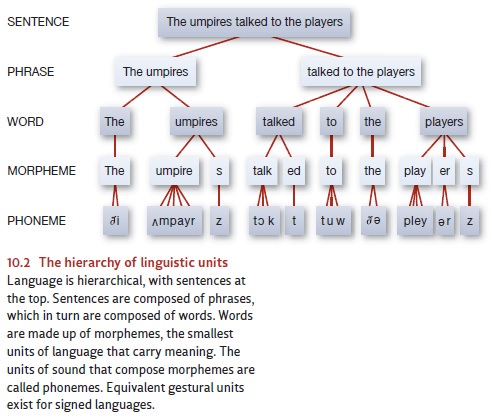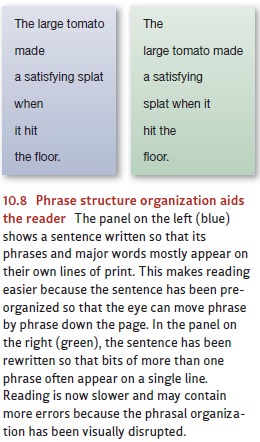Chapter: Psychology: Language
Building Blocks of Language: Phrases and Sentences
Phrases and
Sentences
Words and phrases now combine to
form sentences. Once again, at this new level of complexity, there are
constraints on the permitted sequences. House
the is red and Whereput you the
pepper? are ungrammatical—not in keeping with the regularities of form
thatcharacterize a particular language. One might at first glance think that
the grammaticality of a sentence is just a matter of meaningfulness—whether the
sequence of words has yielded a coherent idea or thought. But this is not so.
Some word sequences are easily interpretable, but still seem badly constructed
(That infant seemssleeping). Other
sequences are not interpretable, but seem well constructed even so(Colorless green ideas sleep peacefully).
This latter sequence makes no sense (ideas neither sleep nor are colorful;
green things are not colorless), and yet is well formed in a way that Sleep green peacefully ideas colorless
is not. Thus grammaticality depends not directly on meaning, but on conformance
with some rule-like system—patterns of sentence formation that are akin to
those of the rules of arithmetic or of chess. Much as you cannot (as a
competent calculator) add 2 and 2 to yield 5 or (as a competent chess player)
move a King two squares in any direction, you cannot put the noun before the
article (as in House the is red) to
yield a sentence in English. So, by analogy to chess, and so on, the patterns
describing how words and phrases can combine into sentences are called the “rules of grammar” or “syntax.”
We should emphasize that we have
not been speaking here about the “rules of proper English” imposed on groaning
children by school teachers and literary critics— rules forbidding the use of
“ain’t,” or of ending a sentence with a preposition. These lat-ter rules are
some people’s prescriptions for how
language should be (rather than how
itreally is), a matter that usually is based on which dialect of the
language has the mostprestige or social cachet (see Labov, 2007). In contrast,
the rules of syntax that we are discussing are the implicitly known
psychological principles that organize language use and understanding in all
humans, including very young children as well as adults, and members of
unschooled societies as well as professors of literature and CEOs of major
corporations.
The study of syntax has been one
of the chief concerns of linguists and psycholin-guists, with much of the
discussion building from the theories of Noam Chomsky (Chomsky, 1965, 1995;
Figure 10.6). As Chomsky emphasized, this interest in the rules governing word
combination is not surprising if one wants to understand the fact that we can
say and understand a virtually unlimited number of new things, all of them “in
English.” We put our words together in ever new sentences to mean ever new things,
but we have to do so systematically or our listeners won’t be able to decipher
the new combinations.

THE BASICS OF SYNTACTIC ORGANIZATION
Consider the simple sentence The zebra bit the giraffe. It consists
of two major subparts or phrases, a noun phrase (the zebra) and a verb phrase (bit
the giraffe). Linguists depict this partitioning of the sentence by means
of a tree diagram, so called because
of its branching appearance:

This notation is a useful way of
showing that individual sentences comprise a hierarchy of structures (as in
Figure 10.2). Each sentence can be broken down into phrases, and these phrases
into smaller phrases. Thus, our verb phrase redivides as a verb (bit) and a noun phrase (the giraffe).


These subphrases in turn break
down into the component words and morphemes. The descending branches of the
tree correspond to the smaller and smaller units of sentence structure. The
whole tree structure is called a phrase
structure description (shown as Figure 10.7).

The phrase structure description is a compact way of describing our implicit knowledge of how sentences are organized. Notice that recurrent labels in these trees reflect the fact that phrases are organized in the same way regardless of where they occur. For example, there are two instances of the label “noun phrase” in Figure 10.7. Each English noun phrase (except for pronouns and proper names) follows the same pattern whether it is at the start, middle, or end of a sentence: Articles such as a and the come first; any adjectives come next; then the noun. This patterning accounts for why anyone who rejects a sentence like The shirt green fit him well as a grammatical sentence of English is guaranteed also to reject Albert is wearing the shirt green and They bought theshirt green at Walmart on Thursday. In essence, then, phrase structure rules define groupsof words as modules that can be plugged in anywhere that the sentence calls for a phrase of the specified type. Other languages choose wholly or partly different orderings of words inside the phrase (e.g., French la chemise verte) and of phrases within the sentence, but they make their phrase structure choices just as regularly and systematically as does English.

Because the phrase structure of a
sentence is its fundamental organizing principle, anything that conforms to or
reveals this structure will aid the listener during the rapid process of
understanding a sentence, and anything that obscures or complicates the phrase
structure will make comprehension that much more difficult. To illustrate, one
investigator asked listeners to memorize strings of nonsense words that they
heard spo-ken. Some of the strings had no discernible structure at all, for
example, yig wur vum rixhom im jag miv.
Other strings also included various function morphemes, for example, the yigs wur vumly rixing hom im jagest miv.
One might think that sequences of the second typewould be harder than the first
to memorize, for they are longer. But the opposite is true. The function
morphemes allowed the listeners to organize the sequence as a phrase structure,
and these structured sequences were appreciably easier to remember and repeat
(W. Epstein, 1961). Figure 10.8 shows that phrase structure organization
facili-tates reading much as it does listening.
Related Topics